Influence of Peptide Conjugation Sites on Lunatin–Alumina Nanoparticles: Implications for Membrane Interaction and Antimicrobial Activity
Abstract
1. Introduction
2. Results
2.1. Synthesis and Characterization
2.2. Biological Assays
2.3. Evaluation of Peptide–Membrane Interactions
3. Discussion
4. Materials and Methods
4.1. Peptide Synthesis
4.2. Preparation of Alumina Nanoparticles and Derivatives Forms
- Alumina nanoparticles (NPs)—Step 1
- Hydroxylation (NP → NP-OH)—Step 2
- Amination of Hydroxylated Alumina (NP-OH → NP-NH2)—Step 3
- Peptide Conjugation (NP-NH2 → Lun-EN or Lun-EC)—Steps 4
4.3. Quantification of Peptide Molecules Bound to the Alumina Nanoparticles
4.4. Morphological and Structural Characterization
4.4.1. Transmission Electron Microscopy
4.4.2. Powder X-Ray Diffraction Analysis
4.4.3. Zeta Potential and Hydrodynamic Diameter Measurements
4.4.4. Fourier Transform Infrared Spectroscopy
4.4.5. Solid-State Nuclear Magnetic Resonance
4.5. Biological Experiments
4.5.1. Antimicrobial Activity Assay
4.5.2. Kinetics of Bacterial Death
4.6. Biophysical Experiments
4.6.1. Preparation of Unilamellar Vesicles
4.6.2. Isothermal Calorimetric Titration
4.6.3. Circular Dichroism Spectroscopy
4.6.4. Differential Scanning Calorimetry
4.6.5. ssNMR for Deuterium-Order Parameters Determination in Labeled Phospholipids
4.7. Enzymatic Degradation Experiment
5. Conclusions
Supplementary Materials
Author Contributions
Funding
Institutional Review Board Statement
Informed Consent Statement
Data Availability Statement
Acknowledgments
Conflicts of Interest
References
- Um dos Maiores Bancos do Mundo Emitiu um Alerta Alarmante Sobre Resistência a Antibióticos|Fórum Econômico Mundial. Available online: https://www.weforum.org/stories/2018/10/one-of-the-worlds-largest-banks-has-issued-an-alarming-warning-about-antibiotic-resistance-with-big-consequences-for-humanity/ (accessed on 11 April 2025).
- Moretta, A.; Scieuzo, C.; Petrone, A.M.; Salvia, R.; Manniello, M.D.; Franco, A.; Lucchetti, D.; Vassallo, A.; Vogel, H.; Sgambato, A.; et al. Antimicrobial Peptides: A New Hope in Biomedical and Pharmaceutical Fields. Front. Cell. Infect. Microbiol. 2021, 11, 668632. [Google Scholar] [CrossRef] [PubMed]
- Hetta, H.F.; Sirag, N.; Alsharif, S.M.; Alharbi, A.A.; Alkindy, T.T.; Alkhamali, A.; Albalawi, A.S.; Ramadan, Y.N.; Rashed, Z.I.; Alanazi, F.E. Antimicrobial Peptides: The Game-Changer in the Epic Battle Against Multidrug-Resistant Bacteria. Pharmaceuticals 2024, 17, 1555. [Google Scholar] [CrossRef] [PubMed]
- Li, W.; O’BRien-Simpson, N.M.; Yao, S.; Tailhades, J.; Reynolds, E.C.; Dawson, R.M.; Otvos, L.; Hossain, M.A.; Separovic, F.; Wade, J.D. C-Terminal Modification and Multimerization Increase the Efficacy of a Proline-Rich Antimicrobial Peptide. Chem. A Eur. J. 2016, 23, 390–396. [Google Scholar] [CrossRef]
- Bucataru, C.; Ciobanasu, C. Antimicrobial peptides: Opportunities and challenges in overcoming resistance. Microbiol. Res. 2024, 286, 127822. [Google Scholar] [CrossRef]
- Li, Y.; Zhang, W.; Zhao, R.; Zhang, X. Advances in oral peptide drug nanoparticles for diabetes mellitus treatment. Bioact. Mater. 2022, 15, 392–408. [Google Scholar] [CrossRef]
- Chen, G.; Kang, W.; Li, W.; Chen, S.; Gao, Y. Oral delivery of protein and peptide drugs: From non-specific formulation approaches to intestinal cell targeting strategies. Theranostics 2022, 12, 1419–1439. [Google Scholar] [CrossRef]
- Kong, X.-D.; Moriya, J.; Carle, V.; Pojer, F.; Abriata, L.A.; Deyle, K.; Heinis, C. De novo development of proteolytically resistant therapeutic peptides for oral administration. Nat. Biomed. Eng. 2020, 4, 560–571. [Google Scholar] [CrossRef]
- Dan, N.; Samanta, K.; Almoazen, H. An Update on Pharmaceutical Strategies for Oral Delivery of Therapeutic Peptides and Proteins in Adults and Pediatrics. Children 2020, 7, 307. [Google Scholar] [CrossRef]
- Abdel-Megeed, R.M. Biogenic nanoparticles as a promising drug delivery system. Toxicol. Rep. 2025, 14, 101887. [Google Scholar] [CrossRef]
- Yadav, K.; Dalal, D. The heterogeneous multiscale method to study particle size and partitioning effects in drug delivery. Comput. Math. Appl. 2021, 92, 134–148. [Google Scholar] [CrossRef]
- Wang, Y.; Sosinowski, T.; Novikov, A.; Crawford, F.; Neau, D.B.; Yang, J.; Kwok, W.W.; Marrack, P.; Kappler, J.W.; Dai, S. C-terminal modification of the insulin B:11–23 peptide creates superagonists in mouse and human type 1 diabetes. Proc. Natl. Acad. Sci. USA 2018, 115, 162–167. [Google Scholar] [CrossRef] [PubMed]
- Santana, H. Determinação Da Diversidade Peptidica Do Veneno Do Escorpião Peruano Hadruroides Lunatus. Ph.D. Thesis, Universidade Federal de Minas Gerais, Belo Horizonte, Brazil, 2012. [Google Scholar]
- Nematollahi, E.; Pourmadadi, M.; Yazdian, F.; Fatoorehchi, H.; Rashedi, H.; Nigjeh, M.N. Synthesis and characterization of chitosan/polyvinylpyrrolidone coated nanoporous γ-Alumina as a pH-sensitive carrier for controlled release of quercetin. Int. J. Biol. Macromol. 2021, 183, 600–613. [Google Scholar] [CrossRef] [PubMed]
- Baiocco, G.; Rubino, G.; Ucciardello, N. Heat Treatment of AZ91 Magnesium Alloy Coated with an Al2O3 Thin Film with Fluidized Bed Technology. Materials 2019, 12, 216. [Google Scholar] [CrossRef] [PubMed]
- Debrassi, A.; Ribbera, A.; de Vos, W.M.; Wennekes, T.; Zuilhof, H. Stability of (bio)functionalized porous aluminum oxide. Langmuir 2014, 30, 1311–1320. [Google Scholar] [CrossRef]
- Bragazzi, N.L.; Gasparini, R.; Amicizia, D.; Panatto, D.; Larosa, C. Porous Alumina as a Promising Biomaterial for Public Health. Adv. Protein Chem. Struct. Biol. 2015, 101, 213–229. [Google Scholar] [CrossRef]
- Denis, C.; Robberecht, L.; Delattre, J.; Deveaux, E.; Hornez, J.-C.; Dehurtevent, M. Effect of dimensional variations on the manufacturing process and the 3D shrinkage ratio of stereolithographic dental alumina ceramics. Dent. Mater. J. 2023, 42, 79–85. [Google Scholar] [CrossRef]
- Ogihara, N.; Usui, Y.; Aoki, K.; Shimizu, M.; Narita, N.; Hara, K.; Nakamura, K.; Ishigaki, N.; Takanashi, S.; Okamoto, M.; et al. Biocompatibility and bone tissue compatibility of alumina ceramics reinforced with carbon nanotubes. Nanomedicine 2012, 7, 981–993. [Google Scholar] [CrossRef]
- Torres, L.; Braga, N.; Gomes, I.; Almeida, M.; Santos, T.; de Mesquita, J.; da Silva, L.; Martins, H.; Kato, K.; dos Santos, W.; et al. Nanobiostructure of fibrous-like alumina functionalized with an analog of the BP100 peptide: Synthesis, characterization and biological applications. Colloids Surfaces B Biointerfaces 2018, 163, 275–283. [Google Scholar] [CrossRef]
- Känkänen, V.; Hirvonen, S.-P.; Teesalu, T.; Hirvonen, J.; Balasubramanian, V.; Santos, H.A. Effects of LinTT1-peptide conjugation on the properties of poly(ethylene glycol)-block-(ε-caprolactone) nanoparticles prepared by the nanoprecipitation method. Drug Deliv. Transl. Res. 2025, 1–16. [Google Scholar] [CrossRef]
- Chu, T.P.M.; Nguyen, N.T.; Vu, T.L.; Dao, T.H.; Dinh, L.C.; Nguyen, H.L.; Hoang, T.H.; Le, T.S.; Pham, T.D. Synthesis, Characterization, and Modification of Alumina Nanoparticles for Cationic Dye Removal. Materials 2019, 12, 450. [Google Scholar] [CrossRef]
- Kathirvel, P.; Chandrasekaran, J.; Manoharan, D.; Kumar, S. Preparation and characterization of alpha alumina nanoparticles by in-flight oxidation of flame synthesis. J. Alloys Compd. 2014, 590, 341–345. [Google Scholar] [CrossRef]
- Webster, T.J.; Hellenmeyer, E.L.; Price, R.L. Increased osteoblast functions on theta+delta nanofiber alumina. Biomaterials 2005, 26, 953–960. [Google Scholar] [CrossRef] [PubMed]
- Pujari, S.P.; Scheres, L.; Marcelis, A.T.M.; Zuilhof, H. Covalent surface modification of oxide surfaces. Angew. Chem. Int. Ed. Engl. 2014, 53, 6322–6356. [Google Scholar] [CrossRef] [PubMed]
- Lee, H.; Jeong, J.H.; Park, T.G. PEG grafted polylysine with fusogenic peptide for gene delivery: High transfection efficiency with low cytotoxicity. J. Control. Release 2002, 79, 283–291. [Google Scholar] [CrossRef]
- Quaglia, F.; Ostacolo, L.; Mazzaglia, A.; Villari, V.; Zaccaria, D.; Sciortino, M.T. The intracellular effects of non-ionic amphiphilic cyclodextrin nanoparticles in the delivery of anticancer drugs. Biomaterials 2009, 30, 374–382. [Google Scholar] [CrossRef]
- Honary, S.; Zahir, F. Effect of Zeta Potential on the Properties of Nano-Drug Delivery Systems—A Review (Part 1). Trop. J. Pharm. Res. 2013, 12, 255–264. [Google Scholar] [CrossRef]
- Akram, S.; Gao, G.; Liu, Y.; Zhu, J.; Wu, G.; Zhou, K. Degradation mechanism of Al2O3 nano filled polyimide film due to surface discharge under square impulse voltage. IEEE Trans. Dielectr. Electr. Insul. 2015, 22, 3341–3349. [Google Scholar] [CrossRef]
- Faghihzadeh, F.; Anaya, N.M.; Schifman, L.A.; Oyanedel-Craver, V. Fourier transform infrared spectroscopy to assess molecular-level changes in microorganisms exposed to nanoparticles. Nanotechnol. Environ. Eng. 2016, 1, 1–16. [Google Scholar] [CrossRef]
- Gupta, V.K.; Agarwal, S.; Saleh, T.A. Synthesis and characterization of alumina-coated carbon nanotubes and their application for lead removal. J. Hazard. Mater. 2011, 185, 17–23. [Google Scholar] [CrossRef]
- Zhang, Y.P.; Lewis, R.N.A.H.; Hodges, R.S.; McElhaney, R.N.; Hodges, R.S. FTIR spectroscopic studies of the conformation and amide hydrogen exchange of a peptide model of the hydrophobic transmembrane alpha-helices of membrane proteins. Biochemistry 1992, 31, 11572–11578. [Google Scholar] [CrossRef]
- Martinez, G.; Millhauser, G. FTIR Spectroscopy of Alanine-Based Peptides: Assignment of the Amide I′ Modes for Random Coil and Helix. J. Struct. Biol. 1995, 114, 23–27. [Google Scholar] [CrossRef] [PubMed]
- Noemi Irazazabal, L. Avaliação Estrutural e Funcional de Novos Peptídeos Antimicrobianos Obtidos a Partir de Desenho Racional. Available online: https://theses.hal.science/tel-01591166v1 (accessed on 13 April 2025).
- Černe, K.; Erman, A.; Veranič, P. Analysis of cytotoxicity of melittin on adherent culture of human endothelial cells reveals advantage of fluorescence microscopy over flow cytometry and haemocytometer assay. Protoplasma 2013, 250, 1131–1137. [Google Scholar] [CrossRef]
- Kuzmin, D.V.; Emelianova, A.A.; Kalashnikova, M.B.; Panteleev, P.V.; Ovchinnikova, T.V. Effect of N- and C-Terminal Modifications on Cytotoxic Properties of Antimicrobial Peptide Tachyplesin I. Bull. Exp. Biol. Med. 2017, 162, 754–757. [Google Scholar] [CrossRef] [PubMed]
- Andrushchenko, V.V.; Aarabi, M.H.; Nguyen, L.T.; Prenner, E.J.; Vogel, H.J. Thermodynamics of the interactions of tryptophan-rich cathelicidin antimicrobial peptides with model and natural membranes. Biochim. Biophys. Acta (BBA) Biomembr. 2008, 1778, 1004–1014. [Google Scholar] [CrossRef]
- Sankaran, S.V.; Saiba, R.; Sikdar, S.; Vemparala, S. Correlation Between Antimicrobial Structural Classes and Membrane Partitioning: Role of Emerging Lipid Packing Defects. J. Membr. Biol. 2024, 257, 307–321. [Google Scholar] [CrossRef]
- Tan, P.; Tang, Q.; Xu, S.; Zhang, Y.; Fu, H.; Ma, X. Designing Self-Assembling Chimeric Peptide Nanoparticles with High Stability for Combating Piglet Bacterial Infections. Adv. Sci. 2022, 9, e2105955. [Google Scholar] [CrossRef]
- Drayton, M.; Kizhakkedathu, J.N.; Straus, S.K. Towards robust delivery of antimicrobial peptides to combat bacterial resistance. Molecules 2020, 25, 3048. [Google Scholar] [CrossRef]
- Chan, W.C.; White, P.D. Fmoc Solid Phase Peptide Synthesis; Practical Approach Series; Oxford University Press: Oxford, UK, 2000. [Google Scholar]
- Dixon, W.T.; Schaefer, J.; Sefcik, M.D.; Stejskal, E.O.; McKay, R.A. Total suppression of sidebands in CPMAS C-13 NMR. J. Magn. Reson. 1982, 49, 341–345. [Google Scholar] [CrossRef]
- Ling, L.L.; Schneider, T.; Peoples, A.J.; Spoering, A.L.; Engels, I.; Conlon, B.P.; Mueller, A.; Schäberle, T.F.; Hughes, D.E.; Epstein, S.; et al. A new antibiotic kills pathogens without detectable resistance. Nature 2015, 517, 455–459. [Google Scholar] [CrossRef]
- da Silva Romeiro, R. Métodos em Bacteriologia de Plantas, 1st ed.; UFV: Viçosa, Brazil, 2001. [Google Scholar]
- Kirby, C.; Gregoriadis, G. Dehydration-Rehydration Vesicles: A Simple Method for High Yield Drug Entrapment in Liposomes. Bio/Technology 1984, 2, 979–984. [Google Scholar] [CrossRef]
- Sreerama, N.; Woody, R.W. Estimation of protein secondary structure from circular dichroism spectra: Comparison of CONTIN, SELCON, and CDSSTR methods with an expanded reference set. Anal. Biochem. 2000, 287, 252–260. [Google Scholar] [CrossRef] [PubMed]
- Davis, J.; Jeffrey, K.; Bloom, M.; Valic, M.; Higgs, T. Quadrupolar echo deuteron magnetic resonance spectroscopy in ordered hydrocarbon chains. Chem. Phys. Lett. 1976, 42, 390–394. [Google Scholar] [CrossRef]
- Batchelder, L.S.; Niu, C.H.; Torchia, D.A. Methyl Reorientation in Polycrystalline Amino Acids and Peptides: A 2H NMR Spin-Lattice Relaxation Study. J. Am. Chem. Soc. 1983, 105, 2228–2231. [Google Scholar] [CrossRef]
- Bukovics, E.R. Storm, Wahrscheinlichkeitsrechnung, mathematische Statistik und statistische Qualitätskontrolle. 284 S. m. 66 Bildern, 53 Tab. u. 17 Tafeln. Leipzig 1965. Fachbuchverlag. Preis geb. MDN 17,50. ZAMM 1966, 46, 405. [Google Scholar] [CrossRef]
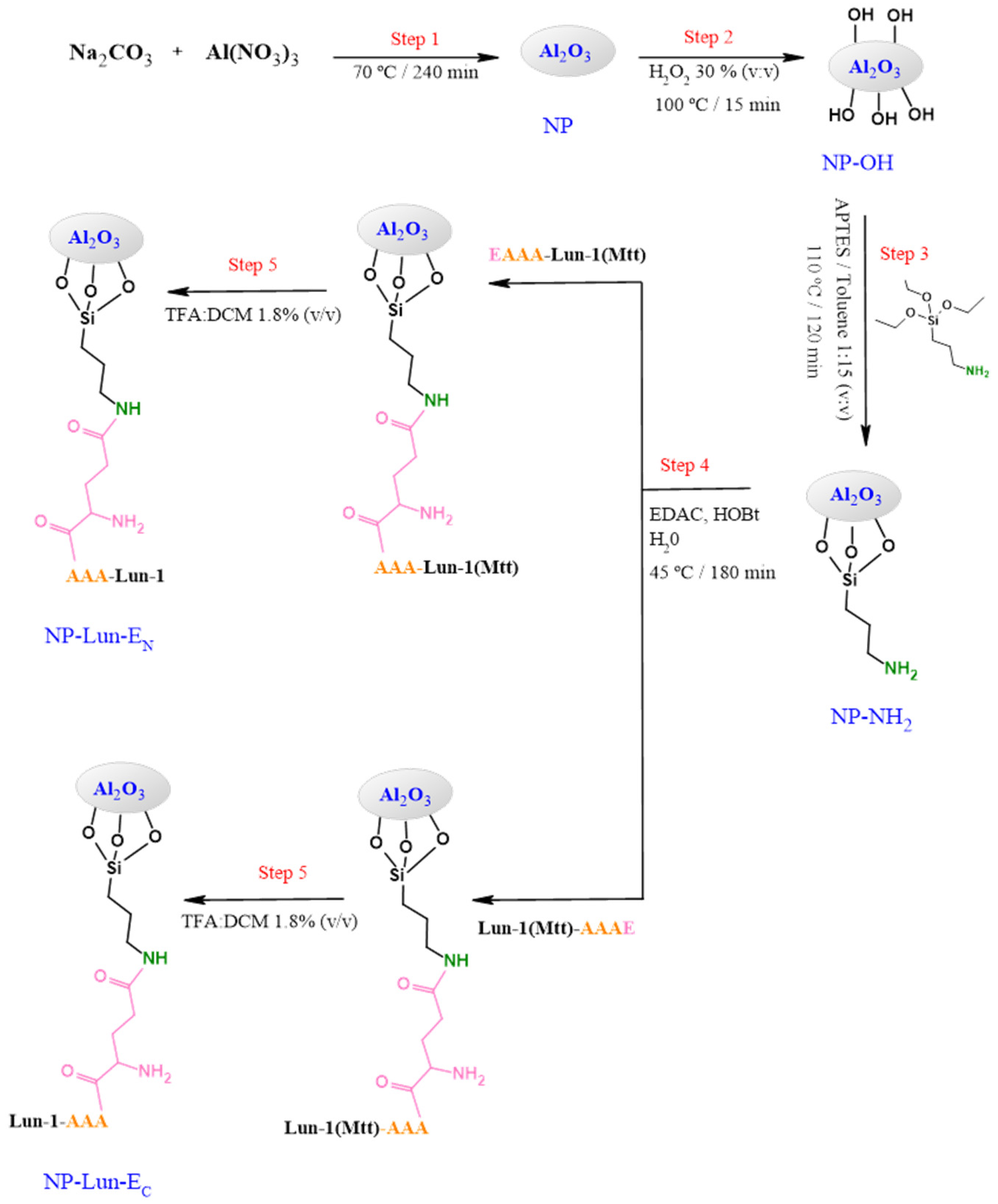
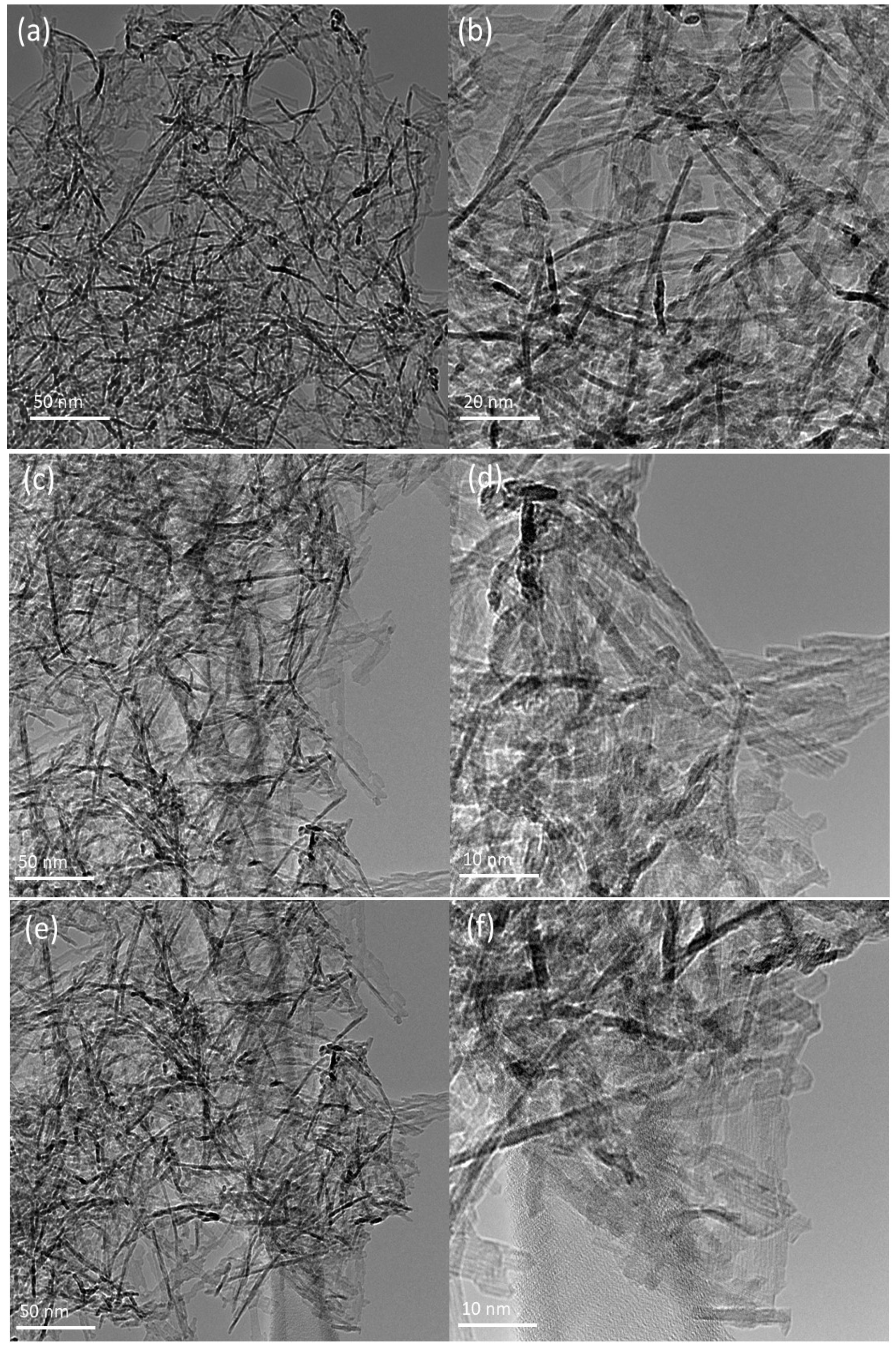


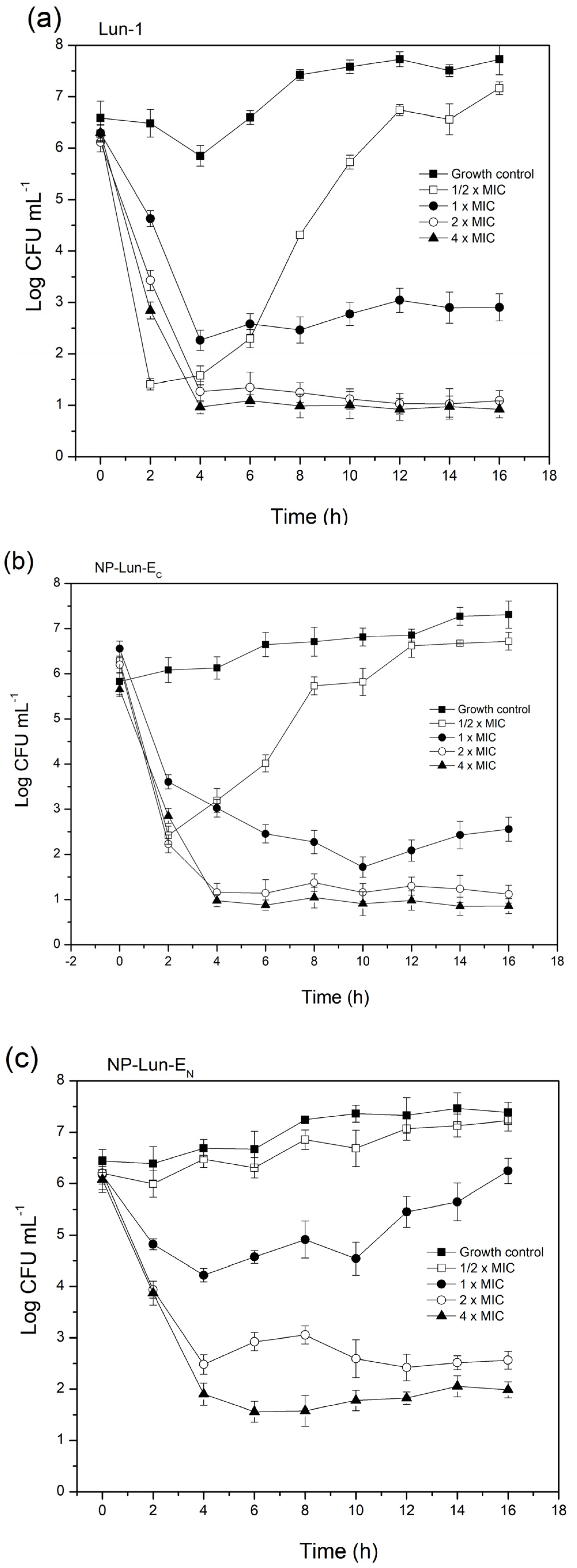
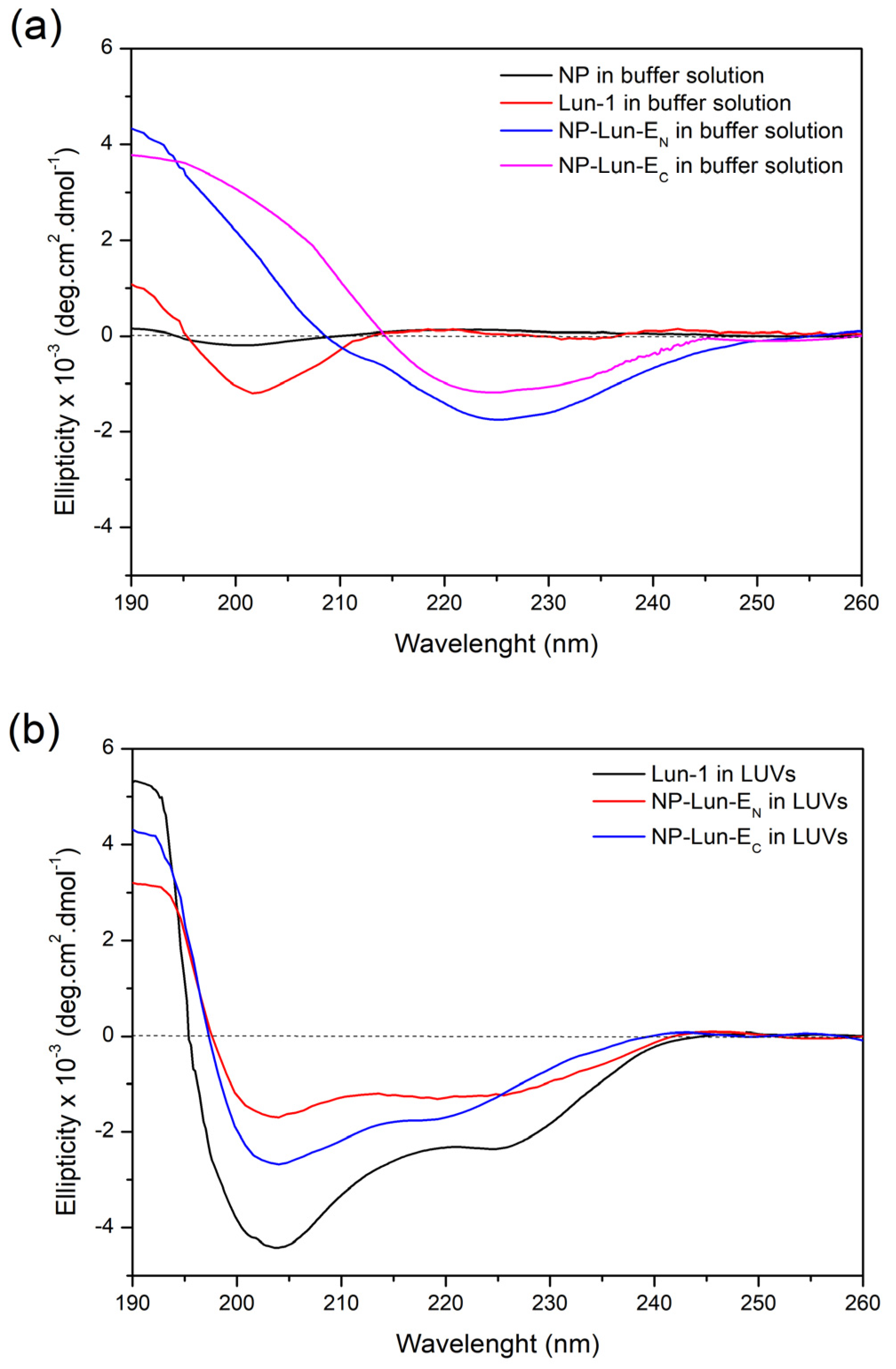
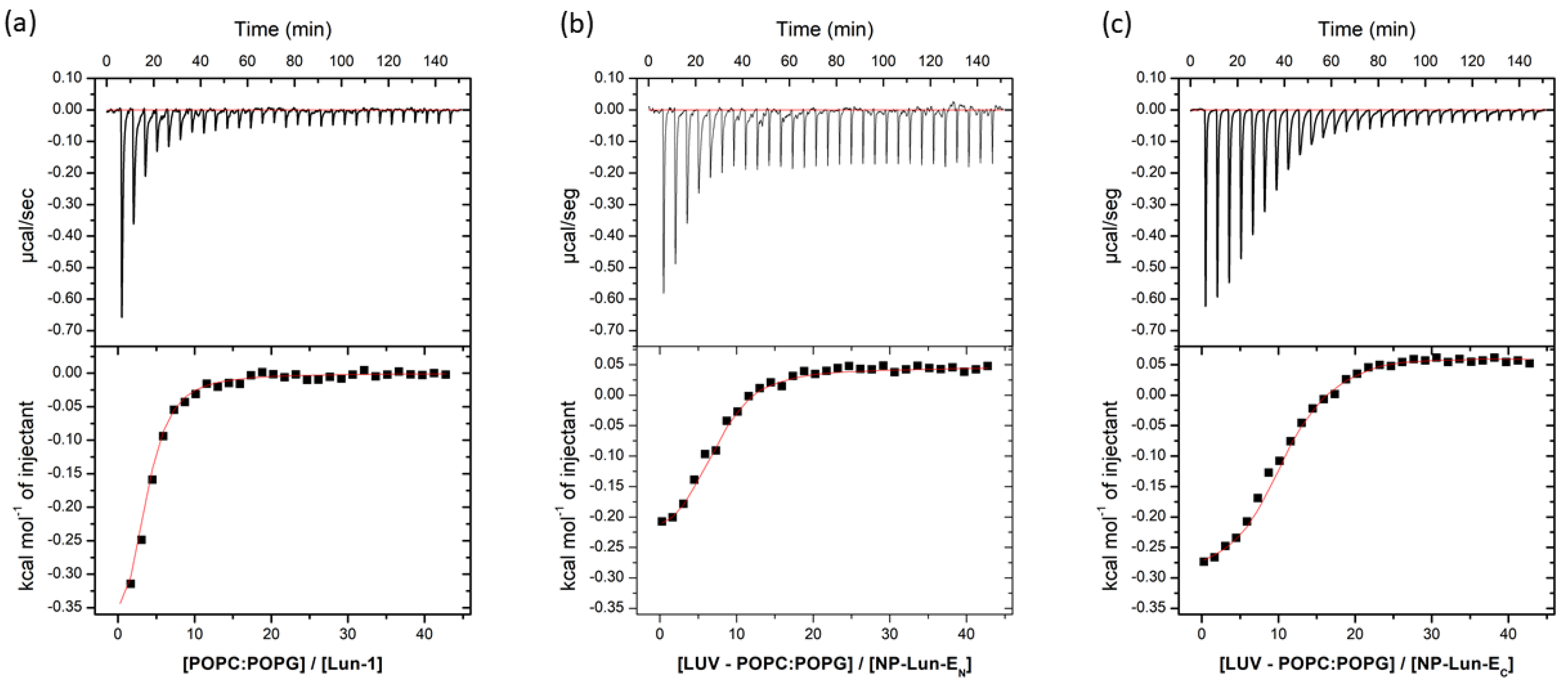


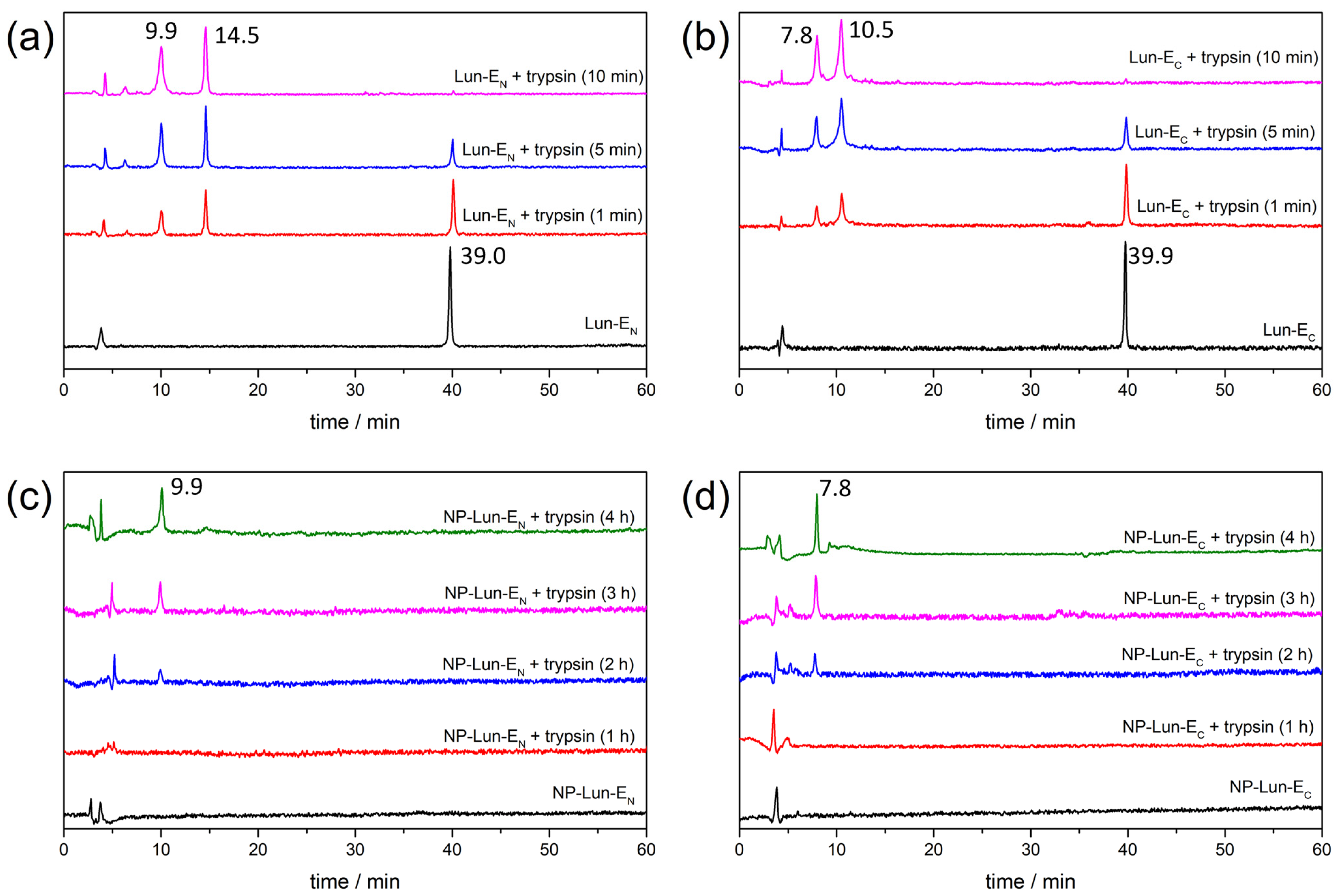
| Peptide Acronym | Primary Sequence | Nanostructure Acronym | Peptide Nanostructure Representation |
|---|---|---|---|
| Lun-1 | FIGGLLKTLTSFF–NH2 | - | - |
| Lun-EC | FIGGLLKTLTSFFAAAE–NH2 | NP-Lun-EC | Lun-1-AAAECterm-NP |
| Lun-EN | EAAAFIGGLLKTLTSFF–NH2 | NP-Lun-EN | NP-NtermEAAA-Lun-1 |
| Microorganism | MIC (µmol·L−1) | ||
|---|---|---|---|
| Lun-1 | NP-Lun-EN | NP-Lun-EC | |
| Acinetobacter (ATCC17978) | 32.1 | ND * | 40.0 |
| Escherichia coli (ATCC25922) | 64.2 | 128.5 | 48.0 |
| Pseudomonas aeruginosa (ATCC27853) | 32.1 | ND * | 32.1 |
| Staphylococcus aureus (ATCC29213) | 8.0 | 64.2 | 16.0 |
| Streptococcus agalactiae (ATCC 29313) | 16.0 | 128.5 | 16.0 |
| Thermodynamic Parameters | Samples (50 µM) | ||
|---|---|---|---|
| Lun-1 | NP-Lun-EN | NP-Lun-EC | |
| n | 7 | 4 | 13 |
| K (L·mol−1) | 3.0 × 104 ± 8.0 × 102 | 5.1 × 103 ± 1.0 × 102 | 4.1 × 104 ± 3.0 × 102 |
| ΔG0 (cal·mol−1) | −5814 | −3478 | −7802 |
| ΔH0 (cal·mol−1) | −450 ± 60 | −200 ± 30 | −650 ± 50 |
| ΔS0 (cal·mol−1.K−1) | 18 | 11 | 24 |
| [Peptide]/µM | Tm (°C)/∆transH (kJ·mol−1) | ||
|---|---|---|---|
| Lun-1 | NP-Lun-EN | NP-Lun-EC | |
| 0 | 23.1/24.0 | 23.1/24.0 | 23.1/24.0 |
| 10 | 22.2/22.1 | 22.9/24.0 | 22.7/23.7 |
| 25 | 21.0/18.4 | 22.9/23.5 | 22.0/22.0 |
| 50 | 19.3/17.3 | 22.9/21.5 | 21.1/19.1 |
| 100 | 18.7/16.2 | 21.9/17.8 | 19.8/16.7 |
Disclaimer/Publisher’s Note: The statements, opinions and data contained in all publications are solely those of the individual author(s) and contributor(s) and not of MDPI and/or the editor(s). MDPI and/or the editor(s) disclaim responsibility for any injury to people or property resulting from any ideas, methods, instructions or products referred to in the content. |
© 2025 by the authors. Licensee MDPI, Basel, Switzerland. This article is an open access article distributed under the terms and conditions of the Creative Commons Attribution (CC BY) license (https://creativecommons.org/licenses/by/4.0/).
Share and Cite
Ferreira, C.S.; Costa, L.M.F.; Nunes, L.O.; de Souza, K.R.; Araújo, G.P.; Salnikov, E.S.; Kato, K.C.; Martins, H.R.; de Castro Pimenta, A.M.; Resende, J.M.; et al. Influence of Peptide Conjugation Sites on Lunatin–Alumina Nanoparticles: Implications for Membrane Interaction and Antimicrobial Activity. Pharmaceuticals 2025, 18, 952. https://doi.org/10.3390/ph18070952
Ferreira CS, Costa LMF, Nunes LO, de Souza KR, Araújo GP, Salnikov ES, Kato KC, Martins HR, de Castro Pimenta AM, Resende JM, et al. Influence of Peptide Conjugation Sites on Lunatin–Alumina Nanoparticles: Implications for Membrane Interaction and Antimicrobial Activity. Pharmaceuticals. 2025; 18(7):952. https://doi.org/10.3390/ph18070952
Chicago/Turabian StyleFerreira, Carolina Silva, Lívia Mara Fontes Costa, Lúcio Otávio Nunes, Kelton Rodrigues de Souza, Giovanna Paula Araújo, Evgeniy S. Salnikov, Kelly Cristina Kato, Helen Rodrigues Martins, Adriano Monteiro de Castro Pimenta, Jarbas Magalhães Resende, and et al. 2025. "Influence of Peptide Conjugation Sites on Lunatin–Alumina Nanoparticles: Implications for Membrane Interaction and Antimicrobial Activity" Pharmaceuticals 18, no. 7: 952. https://doi.org/10.3390/ph18070952
APA StyleFerreira, C. S., Costa, L. M. F., Nunes, L. O., de Souza, K. R., Araújo, G. P., Salnikov, E. S., Kato, K. C., Martins, H. R., de Castro Pimenta, A. M., Resende, J. M., Bechinger, B., & Verly, R. M. (2025). Influence of Peptide Conjugation Sites on Lunatin–Alumina Nanoparticles: Implications for Membrane Interaction and Antimicrobial Activity. Pharmaceuticals, 18(7), 952. https://doi.org/10.3390/ph18070952








